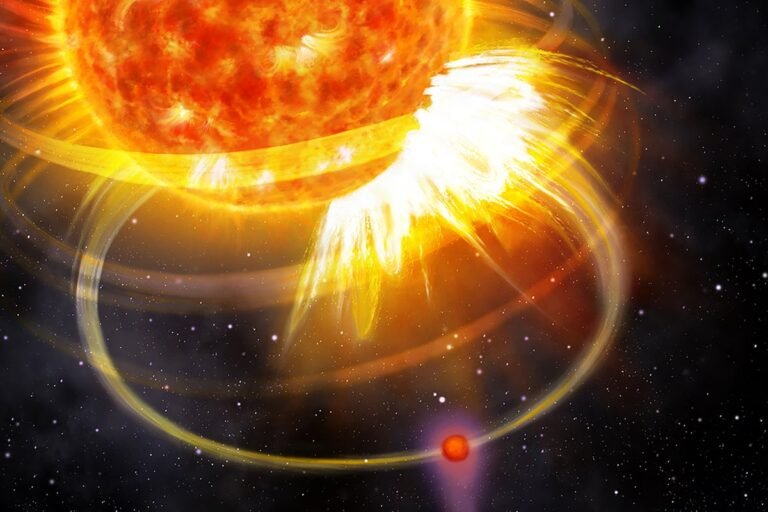Astronomers Found the Most Self-Destructive Planet in the Sky
This planet triggers flares on its star—spelling its ultimate doom
In this artist’s impression, the planet HIP 67522 b sends a wave of energy along magnetic field lines toward the surface of its host star—triggering a massive flare when the energy reaches the star’s surface.
Stars often whip their planets with solar winds and radiation, pull them ever closer with gravity and sear them with heat. But a newfound planet exerts an unexpectedly strong—and ultimately self-destructive—influence on its star in return.
The star HIP 67522 is slightly larger than our sun and shines roughly 408 light-years away in the Scorpius-Centaurus star cluster. It’s 17 million years old, a youngster by stellar standards, and has two orbiting planets that are even younger. The innermost of these two planets, a Jupiter-size gas giant called HIP 67522 b, orbits HIP 67522 at a distance of less than 12 times the star’s radius—almost seven times closer than Mercury’s distance from the sun in our Solar System. This in-your-face proximity, combined with HIP 67522’s volatile teenage nature, has created a spectacle astronomers have never seen before: a planet that triggers powerful flares on the surface of its host star, leading to the planet’s own slow destruction.
“In a way, we got lucky,” says Ekaterina Ilin, an astrophysicist at the Netherlands Institute for Radio Astronomy (ASTRON), who led the study on the HIP 67522 system, published on Wednesday in Nature. “We took all the star-planet systems that we knew of and just went ahead looking for flares—sudden intense bursts of radiation coming from the star’s surface.” Parsing through the data gathered by two space-based telescopes, NASA’s TESS (Transiting Exoplanet Survey Satellite) and the European Space Agency’s CHEOPS (Characterizing Exoplanet Satellite), Ilin’s team noticed that HIP 67522’s flares seemed to be synchronized with its closest planet’s orbital period. And those flares were gigantic—“thousands of times more energetic than anything the sun can produce,” Ilin says.
On supporting science journalism
If you’re enjoying this article, consider supporting our award-winning journalism by subscribing. By purchasing a subscription you are helping to ensure the future of impactful stories about the discoveries and ideas shaping our world today.
The planet HIP 67522 b suffers severe consequences from flares on its host star: the high-energy radiation blasts atmosphere off of the low-density planet, threatening to eventually bring it down from a Jupiter-size world to a Neptune-size one.
Janine Fohlmeister/Leibniz Institute for Astrophysics Potsdam
The orbiting gas giant likely sparks these powerful flares by perturbing the star’s strong magnetic field lines as it passes by in its orbit. This sends waves of energy downward along the lines—and when those waves meet the star’s surface, a flare bursts out. The star’s magnetic loops are “almost like a spring waiting to be let go,” Ilin says. “The planet’s just giving it this last push.” Based on the team’s observations, HIP 67522 b triggers a flare once every Earth day or two.
And this action has severe consequences for the planet itself: Ilin estimates the unlucky gas giant gets six times more radiation than it would if it wasn’t triggering flares and blasting away its own atmosphere. At this pace, Ilin’s team says, HIP 67522 b will shrink from Jupiter’s size to Neptune’s in about 100 million years. “Flaring might cut the lifetime of the planet’s atmosphere in half,” she says.
Researchers had suspected this type of star-planet interplay might occur, but they had never previously seen it, says Antoine Strugarek, an astrophysicist at the French Alternative Energies and Atomic Energy Commission’s (CEA’s) center CEA Paris-Saclay, who was not involved in the new study. “This is the first time we see very convincing evidence such interaction has been actually detected,” he says.
Ilin says it’s too early to draw far-reaching conclusions from this first example of the phenomenon. As a next step, she says, researchers can compare HIP 67522 b with the other planet in the system, which orbits a bit farther from the star, to calculate how much mass the more closely orbiting world is actually losing through this process compared with the more distant one, which is likely only hit with random flares.
Another unanswered question is exactly how the flare triggering works. “Is it a wave [of magnetic energy] that propagates from the planet?” Ilin wonders. She suggests that what happens could be similar to an effect that has been seen on the sun: smaller solar flares sometimes perturb nearby magnetic loops and tip them over the edge to snap and produce a larger flare.
But perhaps the most important question is how common the newly observed phenomenon is. For now, Ilin wants to focus on finding more systems where planets induce stellar flares that scientists can study. “Once we figure out how it works, we can turn it into a planet-detection technique,” she says. Instead of searching for the planets themselves, researchers could look for stars that flare following a certain pattern—suggesting they, too, might have planets with a self-destructive bent.
